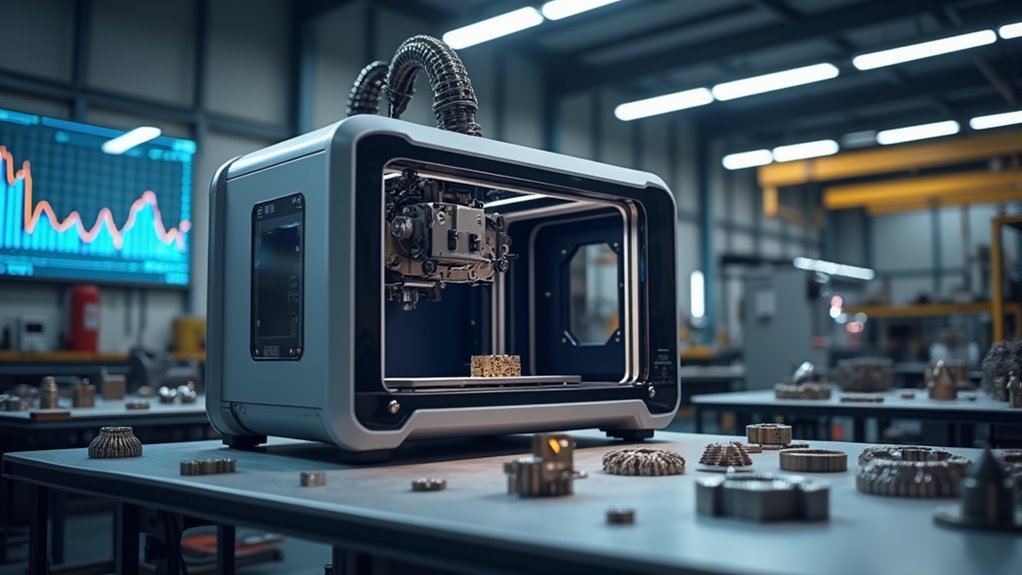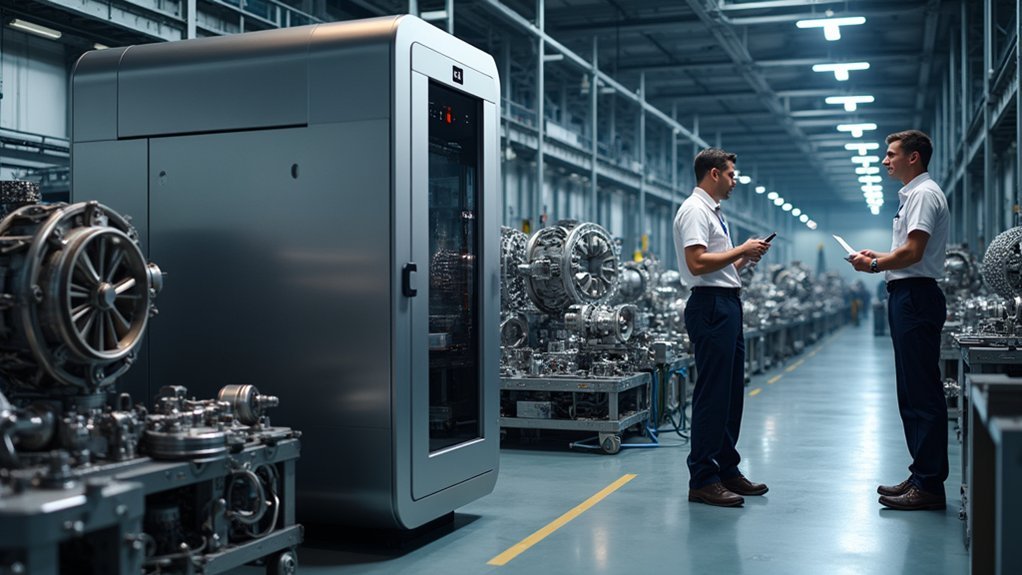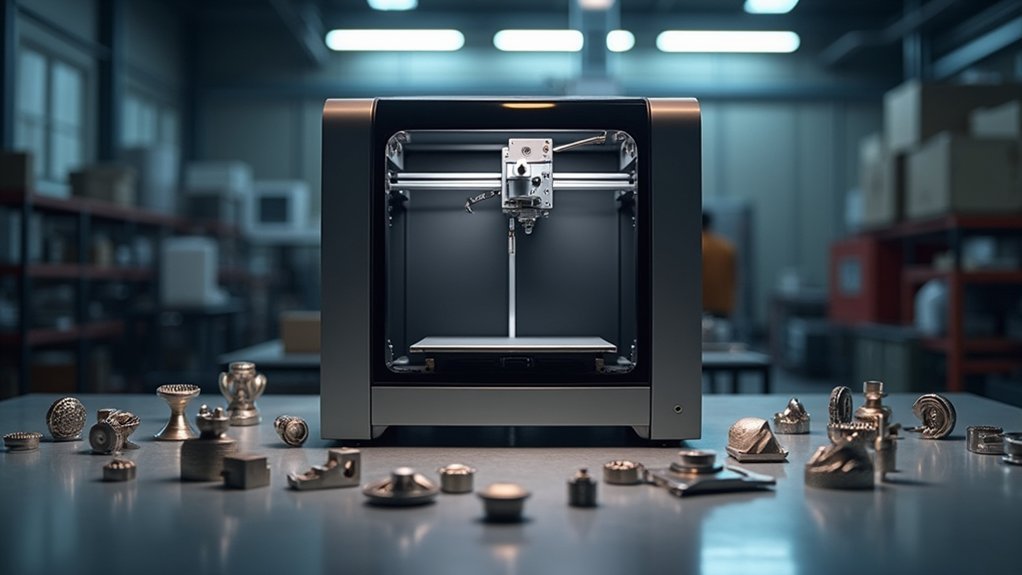You’re positioned to capitalize on the metal 3D printing market’s explosive 25% annual growth rate, with projections exceeding $10 billion by 2030. Patent expirations are democratizing access to previously expensive technology while reducing equipment and material costs. You’ll gain competitive advantages through 60% weight reductions in components, 90% material waste reduction, and substantial labor cost savings. Early adoption positions you for higher profit margins in aerospace, automotive, and medical device manufacturing. The extensive benefits below reveal why timing is everything.
Metal 3D Printing Market Growth Projections Through 2030

Twenty-five percent annual growth isn’t just impressive—it’s transformative for the metal 3D printing industry.
This isn’t gradual evolution—it’s a manufacturing revolution that’s reshaping entire industries at breakneck speed.
You’re looking at a market that’ll exceed $10 billion by 2030, creating massive opportunities for early adopters. This explosive growth stems from aerospace and automotive companies demanding lightweight, customized components that traditional manufacturing can’t deliver efficiently.
You’ll benefit from Industry 4.0 integration that’s revolutionizing metal 3D printing services through automation and data analytics.
As new alloys and improved printing methods emerge, you’ll access broader applications and enhanced accessibility.
Additive Manufacturing isn’t just evolving—it’s becoming essential for competitive advantage. The companies investing now will dominate tomorrow’s manufacturing landscape, while those waiting risk falling behind permanently.
Initial Investment Costs Vs Long-Term Manufacturing Savings
While metal 3D printer investments can shock your budget initially—ranging from $50,000 for basic models to over $1 million for industrial systems—you’ll recover these costs through substantial manufacturing savings that traditional methods can’t match.
Your initial investment costs become justified when you consider the dramatic reduction in material waste and labor expenses. You’ll spend $15 to $800 per piece, often beating traditional manufacturing costs for complex parts requiring multiple production steps.
Additionally, you’ll eliminate storage and inventory expenses through just-in-time production capabilities. As automation advances, your operational costs will continue decreasing, delivering even greater long-term savings while positioning your business ahead of competitors still relying on outdated manufacturing processes.
Strategic Advantages in Aerospace and Defense Industries

These long-term savings become even more pronounced when you examine specific high-stakes industries where precision and performance aren’t negotiable.
In aerospace and defense, Metal 3D Printers deliver strategic advantages that traditional manufacturing simply can’t match. You’ll achieve up to 60% weight reduction through complex geometries that improve fuel efficiency dramatically.
Technologies like Selective Laser Melting (SLM) enable you to create turbine blades and fuel nozzles with intricate internal cooling channels, enhancing performance in extreme conditions.
SLM technology creates complex internal cooling channels in turbine components that traditional manufacturing methods simply cannot achieve.
You’ll accelerate development cycles through rapid prototyping and customization, responding quickly to changing military requirements.
On-demand production eliminates inventory costs and supply chain complexities, streamlining operations while minimizing critical downtime during defense operations.
Medical Device Manufacturing Revolution and Profit Margins
Medical device manufacturing transforms profit margins when you harness metal 3D printing’s precision capabilities for patient-specific solutions.
You’ll customize implants and prosthetics to individual anatomies, delivering superior fit and outcomes that command premium pricing. Your metal printing technology produces complex geometries that eliminate multiple components, streamlining your manufacturing process while cutting costs greatly.
You’ll achieve faster production times, responding quickly to market demands and reducing time-to-market for new products. The technology creates parts up to 60% lighter than traditional devices, enhancing patient comfort and usability.
As personalized medicine trends accelerate alongside high-performance device demand, you’ll capture higher profit margins by positioning your company at the forefront of this medical manufacturing revolution through advanced metal printing adoption.
Supply Chain Independence and Production Flexibility Benefits

You’ll break free from external supplier bottlenecks by bringing metal component production in-house with 3D printing technology.
When supply chain disruptions hit your industry, you won’t scramble for alternatives because you’ll control your own manufacturing timeline.
Your production team can pivot quickly to new designs or specifications without waiting weeks for retooling or supplier approvals.
Reduce External Dependencies
When global supply chains face disruption, metal 3D printers offer manufacturers a powerful solution for achieving greater independence and operational control.
You’ll minimize reliance on external suppliers by bringing critical part production in-house, dramatically reducing lead times in aerospace and automotive applications. Metal printers enable you to produce specialized components that aren’t readily available through traditional suppliers, eliminating bottlenecks that typically slow operations.
When design changes arise, you can adapt quickly without waiting for external manufacturers. Printing metal components on-demand means you’ll respond swiftly to market demands while reducing inventory costs.
The technology allows production of complex geometries and lightweight structures that enhance your manufacturing flexibility. As metal 3D printing continues advancing, you’ll achieve greater manufacturing autonomy, ensuring operational continuity even during global supply chain disruptions.
Rapid Production Adaptability
Beyond reducing external dependencies, metal 3D printing transforms your entire production timeline through unprecedented adaptability. When market demands shift or disruptions occur, you can’t afford to wait weeks for external suppliers. Your industrial 3D printer becomes your strategic advantage, enabling immediate response to changing requirements.
Here’s how rapid production adaptability revolutionizes your operations:
- Instant Design Iteration – Modify components and produce prototypes within hours, not months.
- On-Demand Manufacturing – Create complex geometries using metal powders without tooling constraints.
- Custom Production Scaling – Adjust quantities and specifications instantly based on real-time market feedback.
This flexibility eliminates inventory bottlenecks while reducing material waste.
You’ll streamline operations, lower costs, and maintain competitive positioning. As industries prioritize agility, your investment in metal 3D printing technology positions you to meet evolving consumer demands effectively.
Technology Maturation Reduces Equipment and Material Costs
You’ll find that advanced laser systems in modern metal 3D printers deliver more precise energy control, reducing material waste and improving part quality.
Your powder preparation costs drop considerably as optimized processing techniques create more uniform particle sizes and better flowability characteristics.
The competitive market’s driving down equipment prices as manufacturers streamline production and offer more cost-effective solutions.
Advanced Laser Systems
As laser technology continues advancing in metal 3D printing systems, you’re witnessing a notable shift toward more affordable and efficient manufacturing solutions.
Advanced laser systems in Selective Laser Melting (SLM) and Direct Metal Laser Sintering (DMLS) have matured considerably, delivering improved precision and efficiency that directly impacts your bottom line.
These technological improvements create three key advantages for your business:
- Reduced Equipment Costs – Ongoing laser optimization is lowering equipment prices, making metal 3D printing accessible to more businesses.
- Faster Production Times – Enhanced laser performance achieves higher build rates, reducing your overall production costs.
- Lower Material Costs – Better powder preparation processes and increased market competition are driving down material expenses.
You’ll find stronger ROI potential through these efficient, high-quality production capabilities.
Optimized Powder Preparation
While laser advancements capture much attention, optimized powder preparation represents the next frontier in making metal 3D printing economically viable for your operations.
You’ll benefit from enhanced processes that improve uniformity and purity, reducing waste during production and creating a truly cost-effective solution. Current high-performance metals range from $300 to $600 per kilogram, with specialty titanium alloys exceeding $1,000, but advancing preparation technologies promise significant cost reductions.
Optimized powder preparation enables more efficient material usage, directly impacting your bottom line. As these techniques mature, you’ll see improved part quality and performance alongside decreasing equipment costs.
This evolution makes metal 3D printing accessible for small to mid-sized businesses, enhancing competitiveness across industries while delivering superior manufacturing results.
Competitive Market Pricing
Technology maturation drives dramatic cost reductions across metal 3D printing equipment and materials, transforming what was once a million-dollar investment into increasingly accessible manufacturing solutions.
You’re witnessing unprecedented market competition that’s reshaping pricing structures across the industry.
Market forces driving lower cost adoption include:
- New supplier competition – Fresh entrants and open-source technologies challenge established manufacturers
- Service outsourcing growth – Companies access metal printing without equipment investment
- Manufacturing process improvements – Advanced laser and powder technologies reduce operational expenses
You’ll find metal printers becoming more affordable as competition intensifies.
Standard materials like stainless steel now cost $50-$100 per kilogram, making projects economically viable.
This competitive landscape means you can leverage professional-grade metal 3D printing capabilities without the traditional financial barriers that previously limited access.
Competitive Edge Through Complex Geometry Manufacturing Capabilities
When traditional manufacturing methods hit their geometric limits, metal 3D printing breaks through those barriers to deliver complex designs that redefine what’s possible in component production.
You’ll gain access to intricate internal structures like lattice frameworks that optimize material usage while achieving superior strength-to-weight ratios. Technologies such as Selective Laser Melting (SLM) precisely fuse metal powder layer by layer, creating geometries impossible through conventional machining.
Metal 3D printing unlocks complex lattice structures and internal geometries that traditional manufacturing simply cannot achieve through conventional methods.
You can reduce component weight by up to 60% while maintaining structural integrity. Aerospace and automotive manufacturers leverage these capabilities to produce turbine blades and gearbox parts that enhance fuel efficiency.
This technology shortens lead times and improves market responsiveness, giving you a competitive advantage. As demand for high-performance, customized components grows, you’ll differentiate yourself while meeting stringent industry requirements.
Government Incentives and Tax Benefits for Advanced Manufacturing
Governments across dozens of countries now recognize metal 3D printing as a strategic manufacturing advantage, offering substantial financial incentives to accelerate your adoption of this technology.
These government incentives can dramatically reduce your initial investment costs and ongoing operational expenses.
You’ll discover three key financial opportunities:
- R&D Tax Credits – Claim significant savings when developing and implementing metal 3D printing technologies.
- Manufacturing Extension Partnership (MEP) Programs – Access federal funding specifically designed for small and medium enterprises adopting advanced manufacturing.
- Local Tax Benefits – Secure reduced property taxes and sales tax exemptions on metal 3D printing equipment purchases.
Additionally, sustainability-focused initiatives provide extra funding for businesses adapting to waste-minimizing technologies.
These combined tax benefits create compelling financial reasons to invest now.
Reduced Labor Costs and Automated Production Workflows
While traditional manufacturing demands extensive manual labor across multiple production stages, metal 3D printing transforms your operational efficiency by automating complex workflows that previously required skilled technicians at every step.
You’ll achieve reduced labor costs through streamlined operations that minimize human intervention while maintaining precision control over production parameters.
These automated production workflows enable you to produce high volumes of parts with considerably fewer assembly steps, reducing human error likelihood.
You can manufacture components up to 60% lighter than traditional methods, cutting operational costs and improving energy efficiency.
Advanced software systems provide precise parameter control, further enhancing automation capabilities.
Material Waste Reduction and Sustainability ROI
You’ll achieve up to 90% material waste reduction with metal 3D printing’s layer-by-layer additive process that eliminates subtractive manufacturing’s excess material removal.
Your powder recycling systems can reuse unsintered material multiple times, dramatically lowering raw material costs and extending your supply chain efficiency.
You’ll also reduce energy consumption through optimized production workflows that require fewer manufacturing steps and minimal post-processing compared to traditional methods.
Minimal Powder Waste
Unlike traditional machining methods that can waste up to 50% of raw materials, metal 3D printing technologies like Selective Laser Melting (SLM) and Electron Beam Melting (EBM) achieve up to 90% material utilization by precisely melting only the metal powder needed for each layer.
This revolutionary approach transforms how you’ll manage manufacturing resources while preventing metal oxidation through controlled environments.
Your powder waste reduction strategy delivers three critical advantages:
- Powder Recycling – You can reclaim and reuse unused metal powder from multiple print jobs.
- Cost Optimization – Higher material utilization directly reduces your expensive metal powder consumption.
- Environmental Impact – Minimal waste generation supports your sustainability initiatives and corporate responsibility goals.
You’ll see faster ROI through efficient resource management, making metal 3D printing an intelligent investment for competitive manufacturing operations.
Recyclable Material Systems
Beyond single-use powder efficiency, metal 3D printing’s recyclable material systems create a closed-loop manufacturing ecosystem that transforms your operational economics. You’ll recover and reuse up to 90% of unused metal powders from previous prints, dramatically reducing material costs while enhancing your sustainability profile.
| Traditional Manufacturing | Metal 3D Printing Systems |
|---|---|
| 90% material waste | 10% material waste |
| Linear material flow | Circular material economy |
| High energy consumption | Reduced emissions output |
Advanced recycling systems minimize your need for new materials, creating substantial ROI through decreased material consumption and lower environmental impact. You’re not just buying equipment—you’re investing in a sustainable manufacturing future that reduces energy consumption and promotes circular economy principles while maintaining high-performance part production.
Energy Efficiency Gains
When manufacturers shift to metal 3D printing, they’ll experience dramatic energy efficiency gains that extend far beyond the print bed itself.
You’ll discover that energy efficiency in manufacturing transforms your entire operation, creating measurable sustainability improvements and cost reductions.
Metal 3D printing delivers energy savings through three key mechanisms:
- Reduced production energy – Companies report significant energy usage reductions during manufacturing processes compared to traditional methods.
- Streamlined operations – Elimination of multiple parts and assembly processes cuts overall energy consumption.
- Lighter component production – Complex geometries with minimal excess material create lighter parts, enhancing fuel efficiency in aerospace and automotive applications.
You’ll find that these energy efficiency improvements directly translate into improved ROI while supporting your organization’s sustainability initiatives through measurably reduced environmental impact.
Rapid Prototyping to Production Timeline Acceleration
As traditional manufacturing methods often require weeks or months to move from initial concept to production-ready parts, metal 3D printing fundamentally transforms this timeline by enabling you to create functional prototypes within days.
The layer-by-layer manufacturing process eliminates traditional tooling requirements, allowing direct shift from design to end-use components.
Metal 3D printing bypasses complex tooling stages, creating a seamless pathway from digital design directly to finished production components.
You’ll achieve production timelines that are up to 60% faster than conventional methods, dramatically improving your time-to-market advantage.
Metal 3D printing supports agile manufacturing practices, letting you adapt quickly to changing market demands and customer specifications.
Advanced technologies like Selective Laser Melting and Direct Energy Deposition maintain precision while enabling higher production volumes, accelerating your entire journey from rapid prototyping to full-scale production.
Service Bureau Revenue Opportunities and Market Demand
While many companies recognize the potential of metal 3D printing, the substantial capital investment required for industrial-grade equipment creates a significant barrier to entry.
This market gap presents lucrative opportunities for service bureaus positioned to meet growing demand from aerospace, automotive, and medical sectors requiring customized, high-performance parts.
Service bureaus can capitalize on three key revenue drivers:
- Competitive pricing – Offering cost-effective production while companies avoid hefty printer investments and expensive metal powders ranging from $50 to over $1,000 per kilogram.
- Specialized expertise – Providing access to advanced technologies that small to mid-sized businesses can’t afford.
- Outsourcing trend – Meeting increasing demand as more companies outsource manufacturing needs for rapid prototyping and batch production.
You’ll benefit from continuous technology advancements enhancing production capabilities across multiple industries.
Patent Expiration Effects on Technology Accessibility
The dramatic shift in metal 3D printing’s economic landscape extends beyond service opportunities as fundamental patent protections reach their expiration dates.
Patent expiration unlocks metal 3D printing innovation, democratizing advanced manufacturing technology for businesses of all sizes.
You’ll witness unprecedented access to previously protected metal laser sintering techniques and other advanced printing technology that was once exclusive to major manufacturers. This patent liberation creates a ripple effect throughout the industry – you can expect lower equipment costs, reduced material pricing, and innovative solutions from new market entrants.
Open-source designs will proliferate, enabling smaller companies to compete without prohibitive licensing fees.
You’ll benefit from enhanced collaboration between manufacturers, resulting in improved features and broader applications. With reduced barriers to entry, more businesses will adopt metal 3D printing, accelerating technological advancement and making sophisticated manufacturing capabilities increasingly accessible to your operations.
Risk Mitigation Through Manufacturing Diversification
Beyond economic advantages, metal 3D printing transforms your operational stability by creating multiple manufacturing pathways that shield your business from traditional production vulnerabilities.
Manufacturing diversification through metal additive technologies provides extensive risk mitigation strategies that protect your operations.
Key protective benefits include:
- Supply Chain Independence – You’ll reduce dependency on external suppliers by producing complex geometries and customized parts in-house, protecting against disruptions and market fluctuations.
- Rapid Response Capabilities – SLM and DED technologies enable quick adaptation to unexpected demand changes or new opportunities without extensive tooling requirements.
- Shortened Lead Times – You’ll gain competitive advantages in aerospace and automotive industries by eliminating outsourcing delays and tooling dependencies.
This operational resilience enhances your ability to navigate evolving manufacturing environments while controlling costs.
Frequently Asked Questions
Is Metal 3D Printing Worth It?
You’ll find metal 3D printing worthwhile if you need complex geometries, reduced waste, and faster prototyping. It’s cost-effective for specialized parts, though you should consider outsourcing before purchasing equipment.
What Is the Future of Metal 3D Printing?
You’ll see metal 3D printing become more affordable as laser technology advances and competition increases. New materials and alloys will expand applications, while outsourcing services will provide cost-effective alternatives.
Can You Make Money With a Metal 3D Printer?
You can definitely make money with a metal 3D printer by offering on-demand printing services, creating custom parts for aerospace and medical industries, and charging premium prices for specialized components.
What Is the Market for 3D Printing Metal?
You’ll find the metal 3D printing market’s currently limited, serving high-end manufacturers and research institutions. Despite entry-level printer growth, industrial metal printing faces restricted demand, expensive materials, and significant barriers limiting widespread adoption.





Leave a Reply